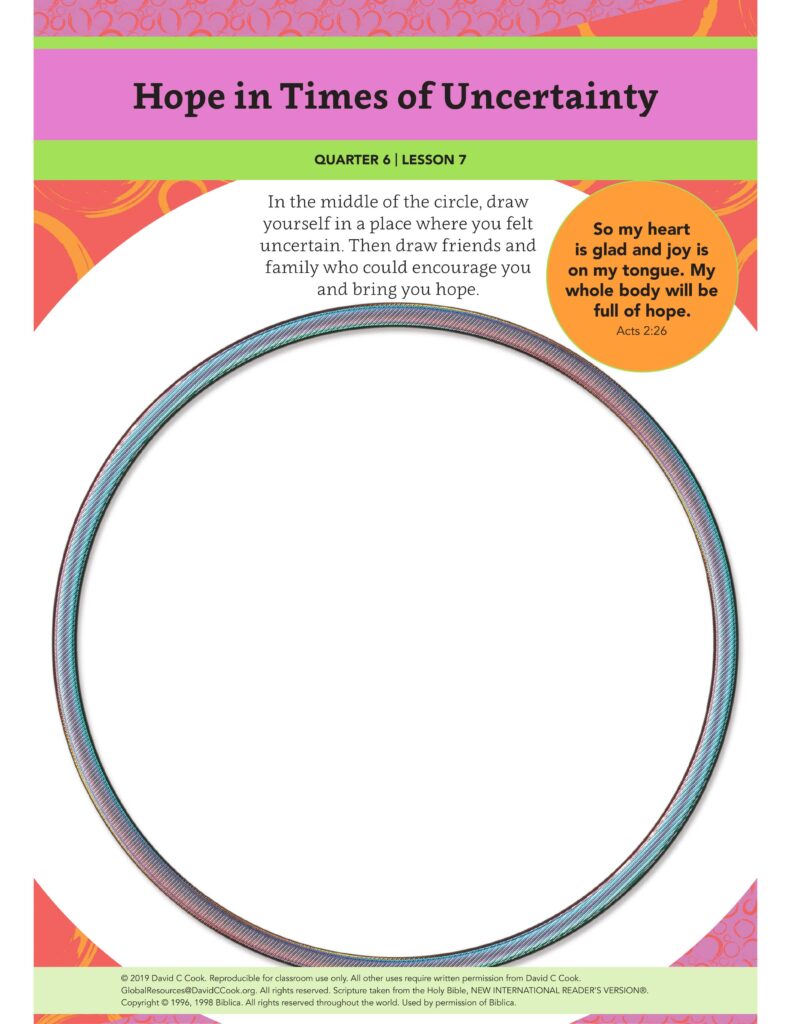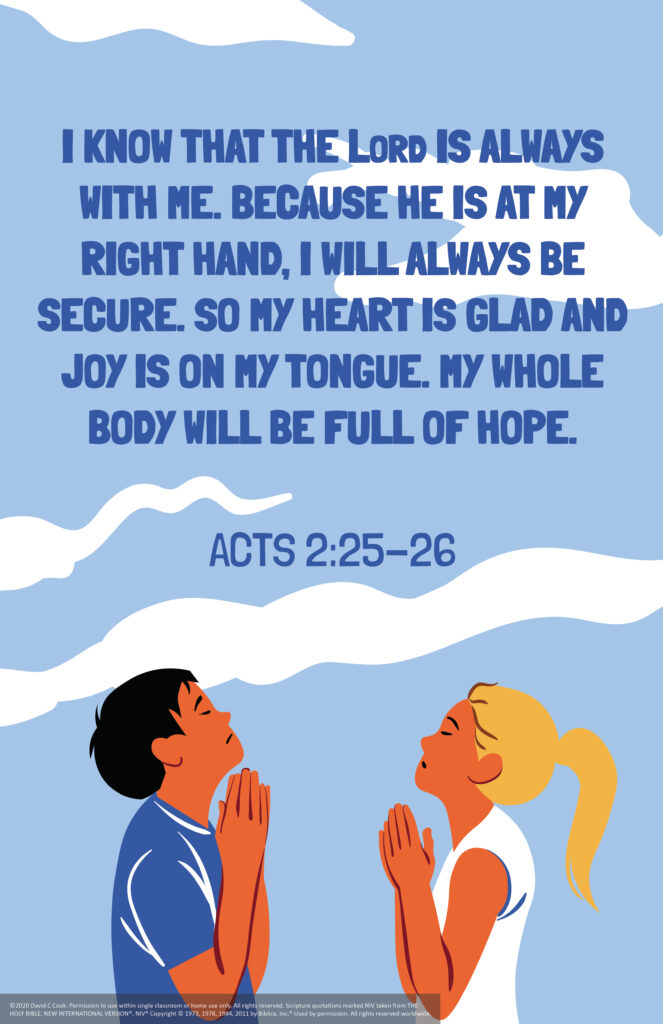During the lesson, the information for you to know is written in regular type, and what we suggest speaking or reading aloud to children is in bold. All resources for this lesson, including the Teacher Guide, Student Page, Family Connection Card, and other resources can be downloaded in a ZIP file by clicking on the following link:
In some lessons you will find "resource articles." These are articles written by experts from around the world to help equip you for your work with children and adolescents. Share them with parents or guardians if you consider it appropriate.
Our hope is certain. It is something for the soul to hold on to. It is strong and secure. It goes all the way to the Most Holy Room behind the curtain. That is where Jesus has gone. He went there to open the way ahead of us.
Hebrews 6:19–20
Our hearts desire security and certainty. We want to know what will happen today, tomorrow, and 10 years from now. So, we set our hopes on securing the things we want and need. When these hopes lead to disappointment, we may begin to experience stress, anxiety, and fear. Though life is filled with uncertainty, we can be certain of one thing: our hope in God. It is strong and secure. When we follow Jesus, we can hold on to the hope that His way is good and right.
Has your hope been shaken by uncertainty? Write a list of the things you hope for. Then pray through your list, giving each one to God. Ask Him to change your heart and mind regarding the hopes that are not in His best plan for your life. Ask Him to guide you in His ways and to change your uncertainties into certainty in Him. When you set your hope on the promises of God, you will never be disappointed.
Encourage families to talk about disappointment. Ask that a family member share an example of something that caused uncertainty and led to disappointment. Then have him share a time when he was uncertain but the situation ended well.
Teacher Tip: If possible, email or text the Family Connection Card to the families of your students.
Greet the children as they come to class. Ask them a difficult question, such as “How many countries are in the world?” Do not share the answer. Let them wonder about the answer until you begin class.
When you arrived today, I asked you a difficult question.
You may be confused or unsure about the answer to my question because I did not share the answer with you. This means you are uncertain. Let’s play a game to help you understand more about uncertainty.
Optional: If you have a phone or CD, you may play a song instead of singing it for the musical chairs activity that follows.
Everyone, stand in a large circle. I will sing a song. When I stop singing and call out, “Stop!” you will quickly sit down where you are in the circle. The last person to sit down will be out of the game.
Sing part of a short song. Call out, “Stop!” at an unexpected time in the song. Do not wait until the song is over to say, “Stop!” Then play again. Encourage the last child to sit down to come and sing the song with you. Continue this process until there is only 1 child still playing or until you have played for 5 minutes. If there is a winner, congratulate her and have all of the children sit in the circle again.
When we played this game, you were uncertain about when I might say, “Stop!” You are still uncertain about the answer to my question at the beginning of class. Sometimes uncertainty is good and fun, as it is with the question and the game. But other times, uncertainty can be frightening. Not knowing what will happen can cause us to worry and our minds to keep thinking about it. Today we will talk more about how we can have hope and peace when we feel uncertain.
Have you ever felt uncertain? What are some examples of things you are uncertain about?
Allow 2–3 children to respond.
I will tell you a true story from the Bible. It is about Peter, one of Jesus’ disciples. Peter’s friend, Jesus, had just died and had come back to life. Peter had seen Him alive! But Jesus had disappeared, and Peter was uncertain about what he should do.
Peter decided to do something he knew how to do well. He went fishing! Before he became Jesus’ disciple, Peter was a fisherman. So, when he was not sure what to do, he fished.
As you share the following section, act out the motions.
Let’s pretend we are fishing. We are in a very big boat! Work together to throw the big, heavy net over the side!
Act as though you are throwing a very large fishing net over the side of a boat. Encourage the children to do the same.
What should we do next?
Allow 2–3 children to respond.
Next, we wait for the fish. That is what Peter and some of the other disciples did. They spent the whole night fishing, but they did not catch any fish. Listen to what happened next. As I read the story, pretend you are waiting for our net to be filled with fish.
Pretend to look over the side of the boat and down at the water. Encourage the children to do the same. Read these verses directly from your Bible.
Early in the morning, Jesus stood on the shore. But the disciples did not realize that it was Jesus. He called out to them, “Friends, don’t you have any fish?” “No,” they answered.
John 21:4–5
How do you think it made the disciples feel that they had not caught any fish?
What do you think happened next?
Listen to what happened next.
[Jesus] said, “Throw your net on the right side of the boat. There you will find some fish.” When they did, they could not pull the net into the boat. There were too many fish in it.
John 21:6
Pretend our net is full of fish. Let’s pull it onto the boat! We have to pull hard because it is very full!
Act as though you are pulling a heavy net of fish onto the boat. Encourage the children to pretend to pull with you.
Now the disciples had a lot of fish. What do you think happened next?
Allow 2–3 children to respond.
The disciples recognized Jesus! Peter jumped in the water and went toward Jesus. The other disciples followed him, dragging a net full of fish along with them. They arrived at the shore and had breakfast with Jesus.
Let’s pretend we are eating breakfast around a fire. We will sit in a big circle, and we will eat bread and some of the fish we caught.
Have the children sit it a circle. Act as though you are eating fish and bread around a fire. Encourage the children to do the same. They will remain in the circle for the rest of the lesson.
At this point in the story, the disciples knew Jesus had risen from the dead, but they did not know when they might see Him again.
How do you think Peter and the disciples felt before they went fishing?
How do you think Peter and the disciples felt when they did not catch any fish?
How do you think Peter and the disciples felt when they saw Jesus?
Peter was not uncertain anymore. Peter knew what he needed to do. He did not know every detail of the things that would happen next. But he did know that he was following Jesus and that he would be with Jesus again someday. He had hope for the future.
We can have hope like Peter did. One thing we can do is to take a step forward when we are uncertain. This is what Peter did. When he did not know what to do, he went fishing. When he saw Jesus, he jumped in the water and ran to Him! And when Jesus later asked him to take care of the church, Peter did. When Peter was uncertain, he found hope in Jesus, and he did what Jesus told him to do.
When you have hope, you usually feel happier and more at peace. Having hope helps you get through difficult and uncertain things. When you are uncertain about something, there are a few tips to help you to have hope.
Tip 1: Talk about it.
Tip 2: Do something familiar.
Tip 3: Ask God for help.
Have the children stand in a circle. Make sure the middle of the circle is clear so that children can move forward without bumping into anything.
We all have things in our lives that cause us to feel uncertain. Think about something you are uncertain about. You do not have to share it with anyone. It can be something fun, such as not knowing when the new baby in your family will be born. Or it can be something that makes you worry, such as not knowing if your family will have enough food to eat tonight. When you think of something you are uncertain about, raise your hand.
Wait until all of the children have raised their hands before continuing the lesson.
We will take a step forward in our uncertainty. Think about 1 thing you can do to find hope in your uncertainty. Use the tips we just talked about or think of something else you could do. For example, if your uncertainty is about the new baby in your family, you could pray that the new baby will be born healthy. If your uncertainty is that your family may not have enough food to eat, you could use an object to talk through your worries. Or you can ask a friend or parent to talk with you.
What is 1 thing you can do to find hope in uncertainty?
When you have thought of something you can do, take a step forward. You can make it a giant step, a hop, or even many tiny steps. Keep moving forward until you are arm to arm with the children standing next to you in the circle.
Wait until all of the children are standing closely together.
We are all together in the middle of the circle! Remember that we are not alone when we are uncertain. We have friends and others who can help us to talk, pray, and act when we feel uncertain. God is with us as well! He loves us and cares for us. He can help us find hope in times of uncertainty.
Optional: If you are using the Student Pages, give the children scissors and crayons to complete their pages. Read through the activity with them and give them at least 5 minutes to complete it.

Our memory verse today reminds us that God is always with us, even when we feel uncertain.
If you are using the Memory Verse Poster, show it to the students.
I know that the Lord is always with me. Because he is at my right hand, I will always be secure. So my heart is glad and joy is on my tongue. My whole body will be full of hope.
Acts 2:25–26

Repeat the motions with the words 3 times. Then end class by saying this blessing, based on John 21:6, over the children:
Blessing: When you are uncertain, may you trust God. May you know that He will bring you hope.
Lead the children in singing this quarter’s song, if possible.
Life on Life ©2020 David C Cook. Reproducible for home or classroom use only. All other uses require written permission from David C Cook [email protected]. All rights reserved.